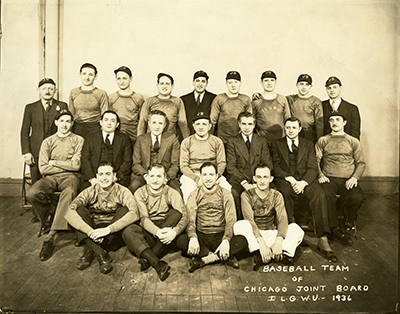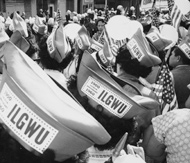

Highlights
The ILGWU Across the USA

The Chicago Joint Board
The cloak industry in Chicago has a very long history, beginning with the organization of the Chicago Cloak Makers’ Union in 1889. In August 1914, The Cloak Operators’ Local 44, the Cloak Cutters’ Local 81, and the Cloak Pressers’ Local 18 united to form the Chicago Joint Board. Shortly thereafter, the new Joint Board achieved a collective agreement with the manufacturers’ association in 1915, and continued to increase organizing efforts and minimum wage scales. Work hours were reduced from 50 to 44 a week and by 1919, week work was instituted for the cloak industry. The dressmakers of the city formed Local 100 in 1915, won a collective agreement with a 40 hour week in 1919, and in 1920 joined the Chicago Joint Board. At the end of 1920, disputes between the Chicago Joint Board and the Cloak Manufacturers’ Association occurred, and in December 1921 there was a five week strike which resulted in the abolishment of week-work abolished and return to the 48 hour work week. The dress trade had an eighteen week general strike in 1924. Soon though, the Joint Board began to make gains, first with the introduction of the 40 hour week in the cloak shops in 1928, and then the two week strike in August 1933 won a collective agreement and 35 hour week for the dressmakers.
Morris Bialis served as the manager for the Chicago Joint Board beginning in 1922, and Morris A. Goldstein served as his long time secretary-treasurer. In December 1939, the Chicago cloakmakers’, one of the oldest groups in the ILGWU, celebrated their fiftieth anniversary, and the Chicago Joint Board celebrated 25 years. During the 1940s, the Joint Board consisted of five locals, Locals 5 (Cloak Operators), 18 (Cloak and Dress Pressers), 59 (Cloak Finishers), 81 (Cloak and Dress Cutters), and 100 (Dressmakers), the encompassed the cloak and silk dress trades. In 1946, the Joint Board purchased a six story building in the Loop to continue to be an instrumental player in labor and community affairs of Chicago.
The Chicago Health Center was opened in 1955, and in 1957, Bialis, who had also been appointed director of the Midwest Region in 1934, was aided by assistant director Harold Schwartz. At the end of the 1950s and beginning of the 1960s, the numbers of retirees increased the need for new workers to maintain payments of benefits in the face of a shrinking garment industry in Chicago. As the Chicago market continued to decline through the 1960s and union membership decreased, by 1974, Local 18 and 59 merged with Local 5, Local 54 merged with Local 76, and Local 208 and 212 merged with Local 261. After 54 years of service, Morris Bialis retired from his role as Joint Board manager in February 1976 (he had been elected an ILGWU vice-president in 1928). Harold Schwartz became the new manager of the Joint Board, as well as Midwest Region director, and Lou Montenegro named assistant director. In November 1978, Schwartz announced his retirement and assistant director Lou Montenegro was elected to succeed him as the regional manager as well as the manager of the Chicago Joint Board. As Chicago saw a rise in sweatshops during the 1980s, Montenegro led the Joint Board.
Kathryn Dowgiewicz


